
'Long-forgotten-people': online representations of the enslaved in Laura Plantation museum
In between the cities New Orleans and Baton Rouge, alongside the Mississippi River, lies an area which is known for its numerous former plantations. This Louisianan region is commonly referred to as the ‘Old River Road’ or the ‘Great Mississippi Road’ in the tourism industry. About a century and a half after the abolition of slavery in 1865, many of the intact former plantations were transformed into so-called plantation museums.
How (not) to represent the history of slavery, the enslaved and African Americans has become an inescapable question in times of the Black Lives Matter movement. As educators, museums play a key role in representing history and people. Over the past decades it has been argued that museums ought to become more inclusive by getting rid of their excluding practices, such as (implicit or unintended) racism and ‘othering’ (Coffee, 2008; Dewhurst & Hendrick, 2017).
These recent developments are of crucial importance for plantation museums. Most plantation museum visitors are White (Alderman et al., 2015) and, most importantly, plantation museums are at the centre of the history of American slavery. Racist ideologies, terror and extreme racial inequality are inherent to American slavery and still have an influence on various segments of contemporary American society (Connell & Reece, 2016; Durr, 2015; Philipsen, 2003). As such, plantation museums have the duty to represent the history of slavery and the lives of the enslaved in such a way that it does justice to the enslaved who cleared the land, tilled the soil, enriched plantation owners and stood at the basis of the development of the United States of America (Davis, 2006; Small, 2013).
Plantation museums have the duty to represent the history of slavery and the lives of the enslaved in such a way that it does justice to the enslaved who cleared the land, tilled the soil, enriched plantation owners and stood at the basis of the development of the United States of America
Laura Plantation: Louisiana’s Creole Site, one of the most popular plantation museums in Louisiana, is part of the well-known cultural tour Old River Road Plantation Adventure. This paper seeks to analyse the discourse of Laura Plantation’s website by means of critical discourse analysis. Tourism websites have largely replaced travel guides: just as travel guides, tourism websites are the first ‘destinations’ of the tourist (Hallet & Kaplan-Weigner, 2010). Sometimes they are even the only destinations, as websites give people the opportunity to get an impression of the places whilst staying at home (ibid.). Therefore, not only the discourses of offline touristic places matter, but also of online places.
Does the content on Laura Plantation’s website challenge or reproduce racist ideologies? Do the representations on the website do justice to the lives of the enslaved and their descendants? Does Laura Plantation play a role in reconstructing racial power relations in the USA in the fight for a more equal society?
From plantation to museum
Laura Plantation is considered to be very unique because of its French-Creole architecture, reppresented by the Big House – the house where the plantation owner and their family lived – and the six remaining authentic slave cabins (National Register Staff, 1992). In 1805, Guillaume Duparc bought the land and instructed 17 enslaved Africans to construct the plantation, including the Big House in ca. 1820 (Alderman et al., 2014; National Register Staff, 1992). 'Slave'-grown sugar, which Louisiana was known for, led to immense wealth for the owners of Laura Plantation (The Cultural Landscape Foundation, n.d.).
In 1805, Guillaume Duparc bought the land and instructed 17 enslaved Africans to construct the plantation, including the Big House in ca. 1820
After Duparc’s death in 1808, the plantation fell into the hands of his wife Nanette. She was the first of the four generations of female plantation owners. During this period, the amount of enslaved on the plantation increased to almost 200 people (The Cultural Landscape Foundation, n.d.). Duparc’s great-granddaughter, Laura Locoul Gare, sold the plantation in 1891 to Florian Waguespack on the condition that the plantation and the Big House would continue to be called ‘Laura’ (National Register Staff, 1992). Waguepack continued the sugar production, but over time some buildings fell into decay. In 1981, four unmarried sisters lived in the Big House, but were also unable to maintain the plantation. They sold it to investors who were planning to remove the plantation in order to build a bridge, but their project failed. The plantation ended up as a deserted place (The Cultural Landscape Foundation, n.d.).
In the beginning of the 1990s, Laura Plantation made it to the National Register of Historical Places and The Laura Plantation Company was established (National Register Staff, 1993; The Cultural Landscape Foundation, n.d.). The Company restored the plantation and transformed it into a for-profit museum (Alderman et al., 2014). The stories that are told at the plantation museum are mostly based on Laura’s memoir Memories of the Old Plantation Home (written in 1936), an account of nearly 100 years of life on the plantation (ibid.).
A Creole ‘world’, owned by women
The symbol of Laura Plantation, which is presented top left of the homepage of Laura Plantation's website, is a portrait of Laura Locoul Gare (figure 1). Not only the name ‘Laura Plantation’, but also the menu option ‘The Life of Laura Locoul’, which presents real-life photos of Laura, confirm that the female figure represents Laura (figure 2).

Figure 1
Particularly the two pictures in the middle of the photo collage strongly resemble the figure. As can be expected, considering the stories that are told in the museum are based on her writing, the website centralises Laura. This also follows from the fact that the website has made a webpage dedicated to Laura.
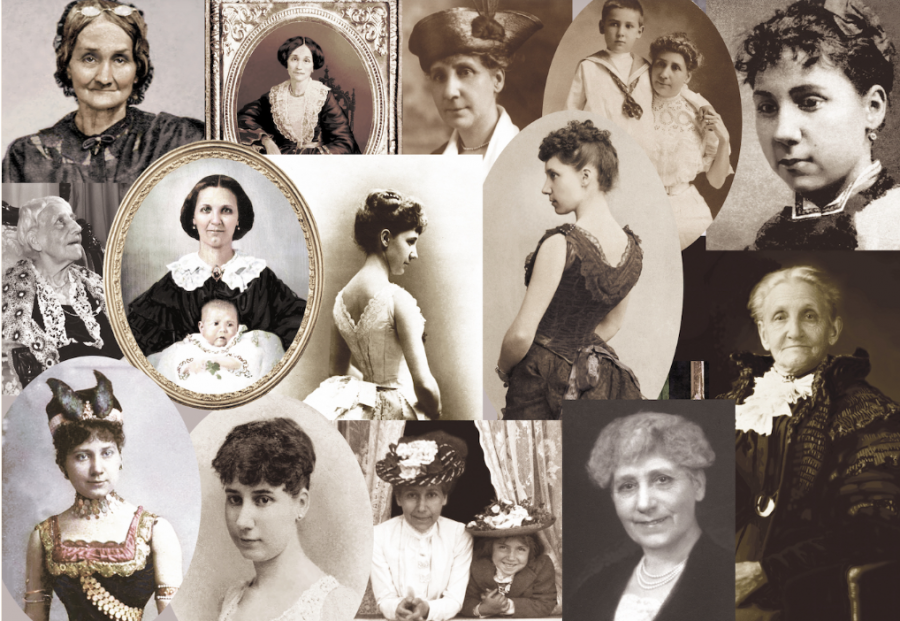
Figure 2
The subtitle ‘Louisiana’s Créole Heritage Site’ shows that the plantation museum is placed in the local historical context of Lousiana’s Creole culture. The fact that the Creole culture is mentioned in the title indicates that this culture is considered to be of great importance in the museum. Top right on the page, a French flag is presented (figure 3). By clicking on the flag, the website's language changes into French. This is the only available translation on the website, which refers to the plantation's French-Creole cultural background.
During the slavery period, Louisiana consisted of ‘Creole people’ with their own ‘Creole culture’ and ‘Creole architecture’. The term ‘Creole’ usually refers to the multi-ethnic and multicultural background of Louisiana’s white citizens (Buman, 2013), but can also refer to ‘racially mixed' people. White Creoles in Louisiana were proud of their French and/or Spanish heritage and resisted the Anglo-Americans who moved to Louisiana for its wealth since the end of the 18th century (ibid.).
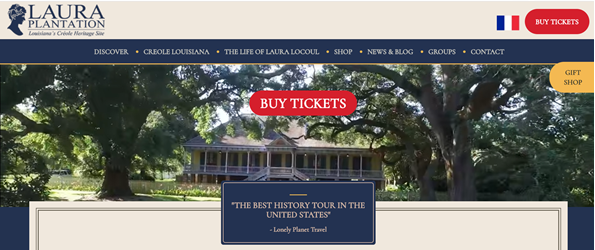
Figure 3
When someone visits the website, the first thing they will notice is the automatically-played short video of the Big House at the top of the page. Beneath this video, a review of the Lonely Planet Travel is highlighted: ‘The best history tour in the United States’ (figure 3). This sentence indicates that the plantation museum highlights the plantation’s history, which is supposed to be of national importance.
Beneath the review, the visitor reads ‘Bienvenue to Laura Plantation, the world of Creole women’ (figure 4). The French word ‘Bienvenue’ and the words ‘Creole women’ again refer to the (French-)Creole cultural background of the plantation. Moreover, the words ‘the world of Creole women’ emphasize the female plantation ownership. The use of the word ‘world’ implies that the plantation represented something ‘big’ or ‘great’ and ‘separate’. This text is accompanied by an image of two white women, of which the one on the left is Laura, and one black woman in the middle. The placement of the white women and the black women next to each other suggests a certain equality between them. Behind the women, the Big House is presented again.
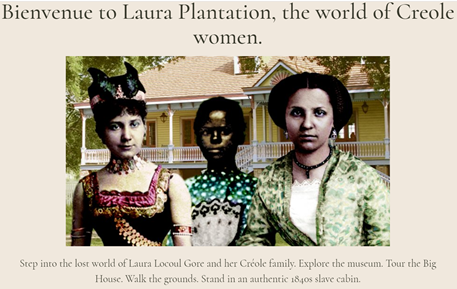
Figure 4
The sentence beneath the image is about the ‘lost world’ of Laura and her family, followed by the words ‘museum’, ‘Big House’, ‘grounds’ and ‘authentic 1840s slave cabin’. This order of words indicates that Laura and her family and their possessions, particularly the Big House, are the highlights of the museum. The combination of the words ‘lost world’ implies a nostalgic feeling: something ‘great’ from the past has been lost. In reality, the ‘world’ of the black woman was considerably different than the ‘world’ of the white women in the image: it was defined by oppression, racial inequality, punishment and forced hard and often dangerous work. This makes the suggestion of equality a horrible myth.
‘Visit today and join us on a journey beyond the myths of the American South and discover the compelling stories of 4 generations of Créole women, both free and enslaved,’ are the last words on the homepage. Here, the writers emphasize the Creole culture and women again. This includes not only white women, but also enslaved black women on the plantation. The words ‘journey’ and ‘compelling stories’ give the plantation an irresistible romantic nature. The sentence ‘beyond the myths of the American South’ suggests the plantation provides alternative, realistic stories of the American South and its past. It makes the reader curious: what is this myth of the South? What is the South’s real story exactly, according to the museum?
A non-racist 'family'?
Information about the history of slavery and the enslaved can be found on the pages ‘Museum Exhibit’, ‘What is Creole?’ and ‘Creoles & Slavery’. The page ‘Museums Exhibit’ discusses the permanent exhibition From the Big house to the Quarters: Slavery on Laura Plantation which opened in 2017. According to the plantation museum, the exhibition is ‘dedicated to telling the authentic story of the slave community on this Créole farm’ (figure 5). By describing Laura Plantation as a ‘farm’ instead of a ‘plantation’, the website gives plantation life a much more pleasant meaning and hides the horrific circumstances for black people on the plantation.
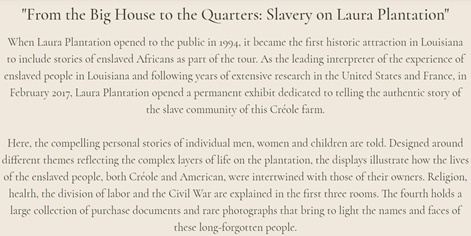
Figure 5
The text acknowledges that the enslaved are ‘long-forgotten-people’; people whose lives and narratives have been overshadowed by the history of the powerful and tucked away at the margins of history for them to collect dust and eventually disappear from USA’s ‘great’ narrative. As American cultural historian David Brion Davis (2006) put it, ‘slavery became the dark underside of the American dream – the great exception to our pretensions of manifestation of national sin.’ Laura Plantation’s exhibition seeks to give the enslaved faces, for instance by presenting pictures of five people (figure 6); however, these pictures are barely put in any context on the webpage.
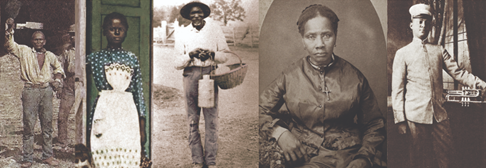
Figure 6
The page tries to introduce the biographies of three enslaved people (figure 7). The most noteworthy element in this text is the last paragraph about Laura’s great-uncle Flagy Duparc who hadchildren with two enslaved Black women.
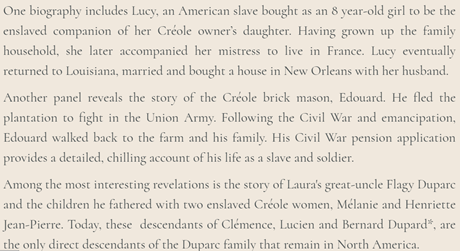
Figure 7
The last name of his heirs differ with one letter, as the white father often did not acknowledge his 'racially mixed' children (figure 8).

Figure 8
However, the writers do not explain why the children were not acknowledged by the father. The website does not mention that this has to do with the preservation of the social order of slavery and white supremacy:
[…] the color line was breached when white men recognized and accorded enslaved women and their mixed-race children status in white society by bequeathing them property and manumitting them. Official recognition by white relatives meant access to whiteness; black personal freedom, combined with access to money and land, was a threat to the social order of slavery and white supremacy. Free blacks, particularly when they had money, were deemed uncontrollable, arrogant, and a bad influence on the bonded. In the eyes of the jurists who ascribed to this view, wealthy free black status was to be denied at all costs, for the benefit of the white social order and the white relatives or creditors seeking to establish their claims to the decedent’s estate (Jones, 2009).
'Racially mixed' children of the White father were considered as 'Black'. The role of racism and the idea of ‘race’ underlying the change of the last name of 'racially mixed' children is entirely ignored on the website.
On the page ‘What is Creole?’, the website presents the ‘philosophy’ of Creole Louisiana (figure 9).

Figure 9
In this philosophy, Creole Louisiana is an alternative ‘family-oriented world’ which is disconnected from the rest of the world and mainstream American individualistic society. The page also sums up other characteristics of Creole Louisiana (figure 10).

Figure 10
Once more, the emphasis is put on the female plantation owners: ‘where women ran business and owned property’. Moreover, the alternative, unique culture of Creole Louisiana is also emphasized by the last sentence: ‘where democratic … American culture’. In this text, the words ‘separate’ and ‘dominant White-Anglo-Saxon-Protestant American culture’ are significant, as they suggest that the Creole Louisianans were completely different from and suppressed by WASP culture.
This idea of ‘Anglo-American aggression and dominance’ goes back to the end of the 18th century when Anglo-Americans moved to Louisiana (Buman, 2013). The Louisiana Purchase in 1803 – an agreement in which France sold an area of 2,1 million km2 to the USA – led to an even greater ‘migration’ of Anglo-American merchants, small farmers and big planters to Louisiana. Hence, Creole Louisianans feared that the Anglo-American culture would dominate and damage the Creole identity and power in Louisiana (ibid.).
However, as slavery was more and more under attack by abolitionists from the North, the Creoles and Anglo-Americans grew closer to each other in order to protect the slave system. Moreover, after the abolition of slavery in 1865 the cultural tensions completely disappeared and made room for racial tensions between Black and White people. From that moment on, White people in Louisiana united – regardless of their wealth, origin or cultural background – under the flag of white supremacy in order to supress the free African American ‘others’ (ibid.). Thus, in the end, it was not about the preservation of ‘Creole culture’, but about the preservation of slavery and white power in Louisiana.
The loss of the Confederacy in 1865 meant the end of the Confederacy and Southern slavery. Out of this defeat the Lost Cause ideology was born. In this ideology, it is claimed that the main cause of Confederacy in the war was not to preserve slavery and white rule, but to protect the ‘Southern culture’ and States’ rights from the ‘Northern aggression’
In fact, after the end of the American Civil War which led to the abolition of slavery, this discourse of 'protecting our culture' continued. The idea of a Creole culture destroyed by the Anglo-Americans is not unique to Louisiana, it is part of a Southern ideology which resulted from the American Civil War, referred to as the ‘Lost Cause’. The Civil War was primarily the result of long-standing tensions between the North and the South regarding slavery (Davis, 2006). After the American War of Independence in 1783, Northern States gradually abolished slavery and began, with the support of Great Britain, to protest against Southern slavery. The ongoing North-South rivalry and the presidential election of Abraham Lincoln – who sought to abolish slavery – in 1860 resulted in the Southern formation of the Confederate States of America and the start of the Civil War in 1861 (ibid.).
The loss of the Confederacy in 1865 meant the end of the Confederacy and Southern slavery. Out of this defeat the Lost Cause ideology was born. In this ideology, it is claimed that the main cause of Confederacy in the war was not to preserve slavery and white rule, but to protect the ‘Southern culture’ and States’ rights from ‘Northern aggression’ (Gallagher et al., 2000). The Confederate leaders denied the fundamental role of slavery in the war in order to maintain their pride (ibid.).
The Lost Cause captured the minds of White Southerners through school textbooks and even Confederate statues which praise(d) the Confederate leaders (Blight, 2001; Gallagher et al., 2000). The successful teachings of the Lost Cause led to the intensification of racism in the form of the Jim Crow laws, lynch law and disfranchisement (ibid.).
The Lost Cause ideology is still alive today; it is intertwined with present-day white supremacy in the US. In Charlottesville in 2017, for instance, we have witnessed white supremacists and neo-Nazis of the "Unite the Right" marching for the preservation of the Confederate statue of Robert L. Lee after the proposald of removing the statue. Peaceful anti-Unite the Right protesters were attacked by white supremacist James Alex Fields Jr. who drove his car into the crowd, killing one person. Or also Southerners who are against the Confederate flag ban and are still waving the flag.
The most remarkable element of the website's text is the statement that ‘race’ was irrelevant for the social status of the individual in Creole Louisiana. Instead, the social status was based on class and family ties, according the website. The text is accompanied by an image of various portraits of White, Black and ‘racially mixed’ individuals (figure 11).
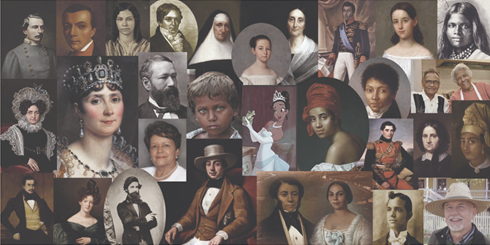
Figure 11
Almost everyone in the image is economically prosperous, which could refer to the idea that everyone is part of the same class. As such, the emphasis lies on an equal, elitist ‘multiracial’ ‘family’.
The denial of ‘race’ is remarkable because American slavery was based on racist ideologies in which people of African descent were perceived as inferior and thus more suited for slavery (Davis, 2006). The website again reproduces the Lost Cause discourse by denying and ignoring the role of slavery, 'race', racism and white rule in Louisiana's society.
In the last paragraph on the page, the Louisianians are not defined as racist perpetrators, but the Anglo-Americans are (figure 12). As such, the website presents Creole Louisianians as victims of the Anglo-American culture.

Figure 12
In this text, the ‘essential nature’ of the Creole culture in Louisiana is represented as non-racist. The culture is described as a ‘vanishing, alternative culture’, which again stimulates a nostalgic feeling: the longing for a lost, non-racist culture, which is destroyed by the dominant, racist Anglo-American culture. This romanticized image of Creole Louisiana is diametrically opposed to the fact that plantation owners in Louisiana, including the plantation owners of Laura Plantation, forced hundreds of enslaved Black people to work on their plantations (Buman, 2013; Davis, 2006). Moreover, Laura Plantation ignores the fact that the White Creoles united with the White Anglo-Americans as soon as Black people were freed.
Also the page ‘Creole & Slavery’, a page consisting of not even 150 words, focusses on the denial of the relevance of the term ‘race’ (figure 13).

Figure 13
People from Creole Louisiana are again defined as non-racist, because, according to the website, they did not only enslave Africans, but also Europeans and Native Americans.
The strong emphasis on the supposedly non-racist character of the Creole Louisianan ‘victims’ leaves no room for the harsh reality and victimhood of the enslaved in Louisiana. The Lost Cause has undeniably infected Laura Plantation museum.
From plantation to myth
The website’s data point at the romanticization of the plantation, the ‘whitewashing’ of the history of slavery and the lives of the enslaved, and an apparent progressivity. Laura Plantation is represented as a nostalgic non-racist Creole world which was in the hands of both white and black women and which was destroyed by the dominant, racist Anglo-Americans. The cruel lives of the enslaved and the underlying racial inequality are entirely denied by the museum. Instead, the website presents a progressive image of Creole Louisiana and Laura Plantation: women held the power in their hands and people were not racist.
By denying racism in times of slavery, the website does not do any justice to the enslaved, whose lives were determined by racial inequality and suppression, and their African American descendants who still feel the effects of slavery today
The term ‘race’ is even irrelevant according to the website. Consequently, the social status and the opportunities for the enslaved are ‘whitewashed’: the denial of the significance of ‘race’ and racial hierarchy implies that Black people had the same status as White people, as long as they were part of the same class. Black and White people together are even represented as a ‘family’ based on equality – a horrible myth when one considers that White plantation owners were able to sell and punish Black people and separate Black families. By denying racism in times of slavery, the website does not do any justice to the enslaved, whose lives were determined by racial inequality and suppression, and their African American descendants who still feel the effects of slavery today. The horrors of slavery and the lives of the enslaved are completely erased, which creates room for a romantized mythical world which consisted of Creole elitist classes, family ties, and ‘race’ and gender equality.
In Laura Plantation's online discourse, the enslaved remain ‘long-forgotten-people’. The fundaments of their lives are denied and the slavery world they inhabited is misrepresented as a nostalgic, progressive world. The romanticization of the plantation, marginalization of enslaved life and the denial of ‘race’ and racism make Laura Plantation museum nothing more than a Lost Cause myth. Laura Plantation argues to ‘go beyond the myths of the South’ and enrich the public with facts, but in reality represents a horrific centuries-old myth and fails to function as a public educator.
References
Alderman, D., Butler, L. en Carter, P. (2014). The House That Story Built: The Place of Slavery in Plantation Museum Narratives. The Professional Geographer, 66(4), pp. 547-557. DOI: 10.1090/00330124.2014.921016.
Alderman, D., Butler, D. en Hanna, S. (2015). Memory, slavery, and plantation museums: the River Road Project. Journal of Heritage Tourism, 11(3). DOI: https://doi.org/10.1080/1743873X.2015.1100629.
Blight, D. (2001). Race and Reuion: The Civil War in American Memory. Cambridge: Belknap Press of Harvard University.
Buman, N. (2013). Two histories, one future: Louisiana sugar planters, their slaves, and the Anglo-Creole schism, 1815-1865 (Dissertation). Louisiana State University, Baton Rouge, Louisiana.
Coffee, K. (2008). Cultural inclusion, exclusion and the formative roles of museums. Museum Management and Curatorship, 23(3), pp. 261-279. DOI: 10.1080/0947770802234078.
Connell, H. en Reece, R. (2016). How the Legacy of Slavery and Racial Composition Shape Public School Enrolment in the American South. Sociology of Race and Ethnicity, 2(1), pp. 42-57. DOI: 10.1177/2332649215582251.
Davis, D. (2006). Inhuman Bondage: The Rise and Fall of Slavery in the New World. Oxford: Oxford University Press.
Dewhurst, M. en Hendrick, K. (2017). Identifying and Transforming Racism in Museum Education. Journal of Museum Education, 42(2), pp. 102-197. DOI: 10.1080/10598650.2017.1311745.
Durr, M. (2015). What is the Difference between Slave Patrols and Modern Day Policing? Institutional Violence in a Community of Color. Critical Sociology, 41(6), pp. 873-879. DOI: 10.1177/0896920515594766.
Hallet, R. en Kaplan-Weinger, J. (2010). Official Tourism Websites: A Discourse Analysis Perspective. Bristol, Buffalo, Toronto: Channel View Publications.
Jones, B. (2009). Fathers of Conscience: Mixed-Race Inheritance in the Antebellum South. Athens and London: University of Georgia Press.
National Register Staff (1992, October). ‘‘Laura Plantation’’. National Register of Historic Places Inventory/Nomination Form. Division of Historic Preservation, Baton Rouge.
Gallagher, G., MacPherson, M. and Nolan, A. (2000). The Myth of the Lost Cause and Civil War History. Bloomington: Indiana University Press.
Philipsen, D. (2003). Investment, Obsession, and Denial: The Ideology of Race in the American Mind. The Journal of Negro Education, 72(2), pp. 193-207.
Small, S. (2013). Still Back of the Big House: Slave Cabins and Slavery in Southern Heritage Tourism. Tourism Geographies: International Journal of Tourism Space, Place and Environment, 15(3), pp. 405-423. DOI: 10.1080/14616688.2012.723042.
The Cultural Landscape Foundation (n.d.). Laura Plantation. Mute Victims of Katrina: Four Louisiana Landscapes at Risk. The Cultural Landscape Foundation.